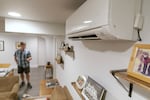The U.S. Department of Energy has awarded Oregon more than $113 million for two new home energy rebate programs aimed at boosting energy-efficient home retrofits targeting low- to moderate-income households.
The Oregon Department of Energy’s new programs will be available for both single-family and multifamily homes. The retrofits could include the installation of heat pumps, smart thermostats or electric water heaters. The money is part of the federal government’s billion-dollar Inflation Reduction Act.
“Our agency will work with our partners and stakeholders to stand up these programs as quickly as possible,” Oregon Department of Energy Director Janine Benner said in a statement.
The funding comes as Oregon continues to support programs to move away from using fossil fuels to power homes and increase the use of electric appliances. Earlier this year, the state was awarded nearly $200 million to lower carbon emissions from three sectors, including buildings.
The rebates announced Wednesday will vary depending on the projects.
The Home Efficiency Rebate program, or HOME, will provide performance-based rebates for energy-efficient retrofits that can demonstrate at least 20% in energy savings. The program could offer higher rebates for projects that show at least 35% in energy savings.
The Home Electrification and Appliance Rebate program, or HEAR, will provide rebates at the time of purchase to low- and moderate-income households who retrofit their homes with high-efficiency electric appliances like electric upgrades, insulation or air-sealing windows.
HOME projects would cover at least 50% of costs, up to $10,000 per project, depending on the household income and how much energy saving was achieved. The HEAR program would also cover at least 50% of project costs, up to $14,000, depending on energy upgrades and the household income. The program is only available to low- to moderate-income households.
Both programs will prioritize households making between 80% to 150% of area median income, and at least 40% of rebates will go to low-income households, with an additional 10% available to low-income multi-dwelling households.
Oregon Department of Energy senior incentives analyst Kristina Donnelly said the programs are designed to meet the needs of different customers.

FILE - The basement of the Musser family home in Portland, is heated with ductless mini-splits, Dec. 1, 2022. The single-family home has been retrofitted to reduce the family’s carbon footprint, and is equipped with solar panels, hybrid heat pump hot water heater, high-efficiency appliances and lighting, an electric vehicle charging station and a whole-home battery storage system.
Kristyna Wentz-Graff / OPB
“So if you have a home that really needs a whole lot of different things in order to make the home comfortable and energy efficient, maybe the HOME’s program is more effective, or if you’re a low-income customer and you really just don’t like your gas stove and you want to install an electric stove, you can do that as well,” she said.
The HEAR program is also specifically designed as an electrification program, she said, where only electric appliances will qualify for a rebate.
People could also receive rebates from both programs, she said.
“However, they are not allowed to receive rebates from both programs for the same measure,” she said. “So, if I selected a heat pump water heater from the HEAR program, I would not be able to count that in my energy savings model for eligibility for the HOMEs program.”
The Oregon Department of Energy estimates about 13,000 households in Oregon could benefit from these programs. It’s currently working on building a website Oregonians can use to see if they qualify.
Donnelly believes the programs will help the states’ lowest-income households the most.
“They are really designed to be deep rebates that will benefit households with the greatest need, especially because the HEAR program has rebates for appliances like electric clothes dryers and electric cooktops,” she said. “The customers will be able to install appliances that maybe they wouldn’t have been able to afford otherwise and there aren’t currently rebates in existence for a lot of those other appliances.”
The state energy department expects both rebate programs to be available by the end of next year.
